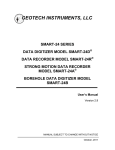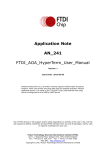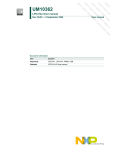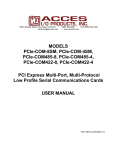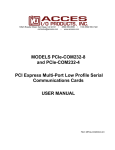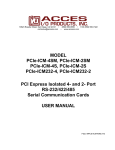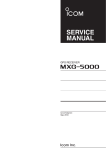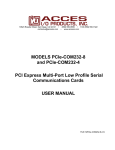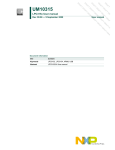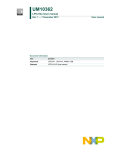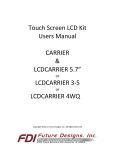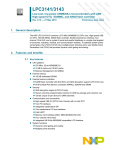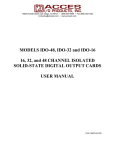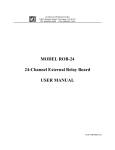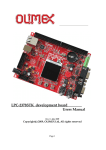Download ANDROID-232 User Manual - ACCES I/O Products, Inc.
Transcript
10623 Roselle Street, San Diego, CA 92121 • (858) 550-9559 • FAX (858) 550-7322 [email protected] • www.accesio.com MODEL ANDROID-232 USB Android Host to RS-232 USER MANUAL FILE: MANDROID-232.A1f 1 Notice The information in this document is provided for reference only. ACCES does not assume any liability arising out of the application or use of the information or products described herein. This document may contain or reference information and products protected by copyrights or patents and does not convey any license under the patent rights of ACCES, nor the rights of others. Printed in USA. Copyright © by ACCES I/O Products Inc, 10623 Roselle Street, San Diego, CA 92121-1506. All rights reserved. WARNING!! ALWAYS CONNECT AND DISCONNECT YOUR FIELD CABLING WITH THE COMPUTER POWER OFF. ALWAYS TURN COMPUTER POWER OFF BEFORE INSTALLING A CARD. CONNECTING AND DISCONNECTING CABLES, OR INSTALLING CARDS INTO A SYSTEM WITH THE COMPUTER OR FIELD POWER ON MAY CAUSE DAMAGE TO THE I/O CARD AND WILL VOID ALL WARRANTIES, IMPLIED OR EXPRESSED. 2 Warranty Prior to shipment, ACCES equipment is thoroughly inspected and tested to applicable specifications. However, should equipment failure occur, ACCES assures its customers that prompt service and support will be available. All equipment originally manufactured by ACCES which is found to be defective will be repaired or replaced subject to the following considerations. Terms and Conditions If a unit is suspected of failure, contact ACCES' Customer Service department. Be prepared to give the unit model number, serial number, and a description of the failure symptom(s). We may suggest some simple tests to confirm the failure. We will assign a Return Material Authorization (RMA) number which must appear on the outer label of the return package. All units/components should be properly packed for handling and returned with freight prepaid to the ACCES designated Service Center, and will be returned to the customer's/user's site freight prepaid and invoiced. Coverage First Three Years: Returned unit/part will be repaired and/or replaced at ACCES option with no charge for labor or parts not excluded by warranty. Warranty commences with equipment shipment. Following Years: Throughout your equipment's lifetime, ACCES stands ready to provide on-site or in-plant service at reasonable rates similar to those of other manufacturers in the industry. Equipment Not Manufactured by ACCES Equipment provided but not manufactured by ACCES is warranted and will be repaired according to the terms and conditions of the respective equipment manufacturer's warranty. General Under this Warranty, liability of ACCES is limited to replacing, repairing or issuing credit (at ACCES discretion) for any products which are proved to be defective during the warranty period. In no case is ACCES liable for consequential or special damage arriving from use or misuse of our product. The customer is responsible for all charges caused by modifications or additions to ACCES equipment not approved in writing by ACCES or, if in ACCES opinion the equipment has been subjected to abnormal use. "Abnormal use" for purposes of this warranty is defined as any use to which the equipment is exposed other than that use specified or intended as evidenced by purchase or sales representation. Other than the above, no other warranty, expressed or implied, shall apply to any and all such equipment furnished or sold by ACCES. 3 Table of Contents Chapter 1: Introduction ................................................................................................. 5 Features...................................................................................................................... 5 Typical Applications .................................................................................................. 5 Functional Description .............................................................................................. 5 Figure 1-1: Block Diagram ...................................................................................... 6 Ordering Guide .......................................................................................................... 6 Model Options ............................................................................................................ 6 Special Order ............................................................................................................. 6 Included with your board .......................................................................................... 6 Optional Accessories ................................................................................................ 6 Chapter 2: Installation................................................................................................... 7 Software Installation.................................................................................................. 7 Hardware Installation ................................................................................................ 9 Chapter 3: Hardware Details ...................................................................................... 10 Figure 3-1: ANDROID-232 Dimensioned Drawing ................................................ 10 USB Connector ........................................................................................................ 10 DC Power Connector ............................................................................................... 10 POWER LED ............................................................................................................. 10 VBUS LED ................................................................................................................ 10 USB Status LED ....................................................................................................... 10 Table 3-1: USB Status LED Indications ................................................................. 10 LOAD Status LED .................................................................................................... 11 FAULT LED ............................................................................................................... 11 DB9 Male Connector................................................................................................ 11 RJ12 Connector (Optional) ..................................................................................... 11 Figure 3-2: ANDROID-232-S01 Dimensioned Drawing ......................................... 11 RJ12 Connector (Model ANDROID-232-S01) ......................................................... 11 J5 Connector (Model ANDROID-232-S01).............................................................. 11 RJ45 Connector (Optional) ..................................................................................... 11 Chapter 4: Address Information................................................................................. 12 Chapter 5: Programming ............................................................................................ 13 FT312 UART interface ........................................................................................ 13 FT311D UART-User Layer ................................................................................... 13 Chapter 6: Connector Pin Assignments .................................................................... 15 Table 6-1: RS-232 Connector Pin Assignments .................................................... 15 Table 6-2: 5VDC Power Connector (J1) Pin Assignments .................................... 15 Table 6-3: ANDROID-232-S01 RJ12 (J3) Connector Pin Assignments................ 15 Table 6-4: ANDROID-232-S01 J5 Connector Pin Assignments ........................... 15 Chapter 7: Specifications ........................................................................................... 16 Customer Comments .................................................................................................. 17 4 Chapter 1: Introduction Features Android USB 2.0 Full-Speed Host to industry standard RS-232 DB9M Serial Port Supports UART interface with RX, TX, RTS and CTS RX buffer size 5512 bytes; TX buffer size 256 bytes Supports baud rates up to 460.8kbps, 921.6kbps optional Use with any Android platform supporting Open Accessory Mode (typically 3.1 or above) Status and fault LEDs including external power, charging status, and USB status Supports USB charging for Android devices ±15kV ESD protection on USB data lines and all RS-232 signals Type A USB connector features industrial strength high-retention design Latching +5V external power input connector Includes 115VAC to +5V regulated external power supply adaptor Industrial operating temperature (-40˚ to +85˚C) standard RoHS Compliant Typical Applications Connecting Android phones to serial accessories Connecting Android tablets to serial accessories Controlling instrumentation from Android devices Home automation via Android devices Data logging from serial accessories Connecting serial printing devices to Android devices Functional Description The ANDROID-232 leverages the power of Android to provide a flexible interface to legacy RS-232 devices. The ANDROID-232 uses the Android Open Accessory (AOA) protocol to convince your Android device (running Android versions above 3.1) that its onboard USB port (normally limited to USB "slave" or "OTG" modes) is actually an RS232 port. Onboard data buffers minimize streaming jitter, and full hardware flow controlled data I/O at up to 921.6kbps is supported (a max of 115.2kbps without flow control). Onboard circuitry will provide power to charge your Android device while connected. Multiple status and fault LEDs complete the package, and allow simple and convenient confirmation of operational state. A hard line wired connection also eliminates security concerns associated with Wi-Fi and other radio frequency solutions. The board is designed to be used in rugged industrial environments (-40˚ to +85˚C) but it is small enough to fit nicely onto any desk or testing station. The board is 3.75 by 1.90 inches and ships with 1/2" standoffs. 5 Figure 1-1: Block Diagram Ordering Guide ANDROID-232 Board on ½” standoffs with a DB9 Male RS-232 connector Model Options -S01 -F -RJ12 -RJ45 RJ12 female for RS-232, including GPS signals on RJ12 and J5 connector 921.6kbps with flow control RJ12 female for RS-232 interface RJ45 female (CISCO RS232 pinout) for RS-232 interface Special Order -S0x Contact factory with your special requirement. Some examples of special orders would be conformal coating, latching I/O headers etc. Included with your board The following components are included with your shipment, depending on options ordered. Please take the time now to ensure that no items are damaged or missing. ANDROID-232 board 4x 4/40 F/F ½” standoffs, installed 6' USB 2.0 Type A to Micro B cable External AC/DC 5V regulated adaptor Optional Accessories ADAP9 CAB-xxxx Screw terminal breakout board with DB9F connector DB9, RJ45, and RJ12 cables are available; please contact us with your exact requirement. 6 Chapter 2: Installation Software Installation It is best to install the software before the hardware. Your software may have been provided on a Software Master CD or other distribution media, or you may need to download it from the product’s webpage. Windows installation (Windows XP and up): • Boot your computer normally. Note: If you already installed the hardware Windows may detect a new plug-and-play device and attempt to install the drivers. If it gives you the option to do so, please cancel the installation wizard; otherwise, wait for Windows to complete the installation. If your installation software was provided on CD or other media: • Insert the installation media and allow the autorun software installation program to start. Note: If the autorun software installation program does not appear, you can launch it manually by clicking on the “Computer” or “My Computer” icon, double clicking on the icon for your installation media drive, and then double clicking on the “autorun.exe” file. • Once the autorun software installation program appears, select the “Install ACCES Software” button. This will start the software and driver installation program. • Select the product from the list, then either click “Install”, or first click the “Change Destination...” button to modify the installation path. Note: You can use the filter feature above the list to reduce the number of products in the list, just type a few characters from the model number into the edit box. You can also narrow the list by selecting a subset of product categories from the drop down list to the right. • After the installation has completed we recommend you click the “Settings...” button, which will run the Settings... program (also available in your Start menu) and configure any necessary option selections for your product, or simply familiarize yourself with its connectors and features, before installing the hardware. 7 If your installation software was downloaded: • Double click the file you downloaded (typically named “{productname} Install.exe”). • Either click the “Install” button to accept the default installation paths for software and drivers, or first select the “Change” buttons to change these paths. • After the installation has completed we recommend you run the “Settings...” / “Setup” program available in your Start menu and configure any necessary option selections for your product before installing the hardware. Then: Click “Finish” to close the install program. Note: During installation, you may see the Microsoft WHQL (Windows Hardware Quality Labs) warning, please choose the “Continue” or “Install this driver software anyway” option, as it is safe to do so. Also note: Windows security may ask you for confirmation that you want to install the device software, several times. You can reduce the number of times this question appears by selecting “Always trust software from...” before clicking “Install” in response to this question. Legacy Windows OS Support: Although official support for Windows operating systems older than Windows XP has ceased, many products work perfectly fine in Windows 95 and up, or Windows 98SE and up. If you have any difficulty installing the software in these legacy operating systems, feel free to contact support for assistance. DOS: Many products are provided with register-level “C” sample programs for DOS, written in Borland C/C++ 3.1 for DOS. Please install the software to a compatible Windows computer to locate these samples. The DOS samples will appear under your installation directory in a DOS subdirectory. Note: DOS executables will not work in operating systems based on NT4, nor any newer Windows version. Please boot to Microsoft DOS 6.22 or above, or any of the many free alternatives (www.freedos.org). Linux: The Linux package can be downloaded from each product page, our github, or in the /Linux directories on the Software Master CD. Consult the provided documentation files for more information. Mac OSX: OSX support for some product lines (notably USB) can be located on the Software Master CD in the “\MAC OS8 9 X” directory tree. If you’re interested in using OSX or other versions of Apple’s operating system, we highly recommend discussing your project with our application engineers. Hardware Installation The ANDROID-232 ships with a regulated +5V power supply. Apply power to the board and then plug in the USB cable to the Android device and the ANDROID-232. Once the USB cable is plugged in and power is applied the board will go through USB enumeration. After enumeration the ANDROID-232 is ready to use. Plug your RS232 device into the DB9 (or RJ12, RJ45) and now you can begin to transmit and receive data. 9 Manual ANDROID-232 Chapter 3: Hardware Details Figure 3-1: ANDROID-232 Dimensioned Drawing USB Connector The USB connector is a Type A high-retention connector and mates with the "A to micro B" cable provided. The USB host port provides access to peripheral hardware from any Android platform with a USB device port. DC Power Connector J1 is a female, 2-pin right-angle latching header. It is part of the Molex Mini-Fit Jr. series (Part# 39-30-1020). It mates with the Molex Mini-Fit Jr. 5557 series. Plug the included external regulated 5VDC power supply into this connector. POWER LED The LED labeled PWR lights GREEN to indicate power to the board. VBUS LED The LED labeled VBUS lights GREEN to indicate power is provided to the ANDROID USB device port. USB Status LED The RED LED labeled USB STAT is used to indicate USB host status. USB Status LED Indication Meaning Illuminated Steady Android device connected and functional Blinks once per second Android device not responding Blinks twice per second Android device not supported Blinks thrice per second USB Hub not supported Table 3-1: USB Status LED Indications 10 Manual ANDROID-232 LOAD Status LED The LED labeled LOAD STAT lights RED to indicate when the ANDROID device is charging. FAULT LED The LED labeled FAULT lights RED to indicate that the USB charging IC is experiencing over-temperature or current limit conditions. DB9 Male Connector The DB9 male connector provides access to the serial signals TX, RX, CTS, RTS and GND. The DB9 uses the standard RS232 serial pinout. Refer to the Connector Pin Assignments chapter for the pinout. RJ12 Connector (Optional) The RJ12 connector provides access to the serial signals TX, RX and GND. CTS and RTS are not accessible. Refer to the Connector Pin Assignments chapter for the pinout. Figure 3-2: ANDROID-232-S01 Dimensioned Drawing RJ12 Connector (Model ANDROID-232-S01) The ANDROID-232-S01 provides an RJ12 instead of a DB9M to provide access to the serial signals TX, RX, GND and GPS signals GPSTX, GPSRX and GPSGND. CTS and RTS are not accessible. Refer to the Connector Pin Assignments chapter for the pinout. J5 Connector (Model ANDROID-232-S01) The ANDROID-232-S01 also provides a three pin PICO embedded connector for access GPS signals GPSTX, GPSRX and GPSGND. The mating connector is a Molex 51021-0300 or equivalent. Refer to the Connector Pin Assignments chapter for the pinout. RJ45 Connector (Optional) The RJ45 connector provides access to the serial signals TX, RX, CTS, RTS and GND. The RJ45 uses the CISCO RS232 serial pinout. Refer to the Connector Pin Assignments chapter for the pinout. 11 Manual ANDROID-232 Chapter 4: Address Information The unit connects to the host Android device using the Android Open Accessory protocol introduced in revision 3.1 of Android. In order to connect your application to any given AOA hardware device, you need to know the identifiers used in that device. The ANDROID-232 uses the following AOA Identifiers Manufacturer: Model: Version: Description: ACCES I/O Products, Inc. ANDROID-232 1.0 Single USB to RS-232 serial port adapter Refer to the various samples provided for more information, if necessary. 12 Manual ANDROID-232 Chapter 5: Programming The ANDROID-232 product includes an Android sample program, with source, which operates within the Android Open Accessory protocol, available on all devices running Android 3.1 or higher (some 2.3.4 ROMs are supported). This program will allow you to verify proper operation of the ANDROID-232 device, including sending and receiving RS232 data. A Python test program that can cooperate with the Android sample program to verify proper receipt of data as transmitted is also provided. In any operating system you can communicate through the ANDROID-232 with your Android device using the standard communication terminal program of your choice; in Windows we provide, and highly recommend, a very powerful terminal program called "WinRISC". Windows samples in a variety of programming languages can be used to jumpstart your Serial COM programming (with full source code). The following data is excerpted from the FT311D and FT312 Data Sheets and Application Notes. The device uses the FT312, but both part numbers apply. FT312 UART interface FT312 provides a UART interface, with baud rates from 300 to 921600. The FT312 UART transmits data in NRZ data format. An FT311UARTInterface class with SetConfig, ReadData, WriteData routines for UART operations, and ResumeAccessory, DestroyAccessory functions to start and stop operations is provided. For details on the use of the Java Class and functions, please see Annex D. of FTDIChip Document Reference No.: FT311D_Android_programmer_guide(FT_000532).pdf Clearance No.: FTDI# 307. To help get you started, the method to add FT311UARTInterface.java into the project in the Eclipse environment is: Copy the file into the src directory, e.g src\com\<package name>. Right click on the project name in Eclipse package explore, then select new->file->src->com->”package name”->advanced->link to the file. FT311D UART-User Layer This section describes the Serial User APIs of FT311UARTInterface class. These are the most common functions of the APIs to use in your Android program. 13 Manual ANDROID-232 SetConfig SetConfig(int baudRate, byte dataBits, byte stopBits, byte parity,byte flowControl) Use this function of the FT311UARTInterface class to set baud rate, data bits, stop bits, parity and flow control of the UART interface. Note: The android application must send this configuration before sending any application data. baudRate dataBits stopBits Parity flowControl baud rate, min 300, max 921600, default set to 9600. data bits, 7: 7-bit databits, 8: 8-data bits, default 8-data bits. stop bits, 1: 1-stop bits, 2: 2-stop bits, default is set to 1-stop bits. parity, 0: none, 1:odd, 2:even, 3:mark and 4:space. default is set to none. flow control, 0: none, 1-cts/rts, default is set to none. Please note: To reliably achieve higher baud rates the use of hardware (cts/rts) flow control is necessary, and is generally a good idea at any baud rate. SendData SendData(byte numBytes, char[] buffer) Use this function of the FT311UARTInterface class to transmit the data buffer out the serial port. numBytes Buffer number of bytes to transmit, maximum 256 per transfer. pointer to data buffer. ReadData ReadData(byte numBytes, byte[] buffer, byte []actualNumBytes) This function of the FT311UARTInterface class is used to receive data from the serial port. numBytes number of bytes to read, MAX 256 per transfer. Buffer pointer to buffer pointer. actualNumBytes the actual number of bytes received, max 61 per transfer. 14 Manual ANDROID-232 Chapter 6: Connector Pin Assignments There are two factory options for alternate (RJ12 & RJ45) connectors for the RS-232 signals and one standard (DB9M) connector. Pin assignments are listed below. PIN 1 2 3 4 5 6 7 8 9 DB9M N/C RX TX N/C GND N/C RTS CTS N/C RJ12 N/C GND RX TX N/C N/C RJ45 N/C N/C N/C GND RX TX CTS RTS Table 6-1: RS-232 Connector Pin Assignments PIN 1 POWER +5VDC 2 GND / RETURN Table 6-2: 5VDC Power Connector (J1) Pin Assignments PIN 1 2 3 4 5 6 RJ12-S01 GPSRX GND RX TX GPSGND GPSTX Table 6-3: ANDROID-232-S01 RJ12 (J3) Connector Pin Assignments PIN 1 2 3 J5 GPSTX GPSRX GPSGND Table 6-4: ANDROID-232-S01 J5 Connector Pin Assignments 15 Manual ANDROID-232 Chapter 7: Specifications Communications Interface I/O Connection: DB9M (optional RJ45 or RJ12) Serial Port: RS-232 signals RX, TX, RTS, CTS, GND Serial Data Rates: 460.8kbps (921.6kbps available), 115.2kbps without RTS/CTS flow control ESD Protection: ±15kV on all signal pins Character Length: 7 or 8 bits Parity: Even, Odd, None, Space, Mark Stop Interval: 1 or 2 bits Flow Control: RTS, CTS Bus Type USB 2.0 Full-Speed USB 3.0 Compatible USB 1.1 Compatible A type A USB connector with a high retention design that complies with the class 1, Div II minimum withdrawal requirement of over 3 pounds of force (15 Newtons) is used. Environmental Operating Temp: -40° to +85°C Storage Temp: -40° to +85°C Humidity: 5%-95%, non-condensing Board Dim.: 1.900 x 3.750 inches Power +5VDC regulated: <100mA typical plus 500mA max when charging ANDROID device 16 Manual ANDROID-232 Customer Comments If you experience any problems with this manual or just want to give us some feedback, please email us at: [email protected]. Please detail any errors you find and include your mailing address so that we can send you any manual updates. 10623 Roselle Street, San Diego CA 92121 Tel. (858)550-9559 FAX (858)550-7322 www.accesio.com 17 Manual ANDROID-232


















